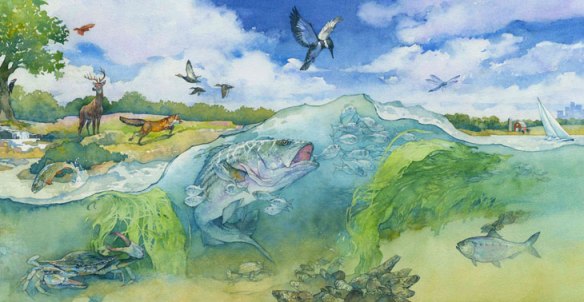[This post also appears on Wiggle Planet’s blog.]
There are many educational games out there that do their best to teach people about the environment. And many of them do a great job.
For example, I really like how Earth Day Canada put together their EcoKids website. The games on EcoKids are mostly simple simulations with engaging action and puzzle-based mechanics, and it’s great how they blend the computer-based games with physical-world activities (e.g., play a game on the computer then go outside and do some recycling). Games that encourage people to make positive changes to their physical world, improving the environment for everyone.
In fact, both the United States Environmental Protection Agency and the National Oceanic and Atmospheric Administration have sites that promote environmental education through games. It’s inspiring for me to see large governmental agencies exploring innovative ways to protect the environment and educate the public.
But there’s another level of immersive environmental education we haven’t even touched yet.
First, a key fact about Nature that we often forget.
Nature likes to hide things. Particularly when something is wrong.
It’s a fundamental trait that has developed in pretty much every species on the planet. Are you sick? Weak? Injured? Well, you better hide it as much as possible, otherwise something will come along, notice you’re indisposed, and then eat you for lunch. This trait also manifests itself in entire networks of interdependent and related organisms (i.e., ecosystems). By the time it’s easy to observe a systemic problem, the damage is often irreversible.
So, it’s not enough for us to be well educated and observant. We need superhuman powers to help us visualize what’s really happening in Nature.
I believe artificial life combined with augmented reality is the magic key. We can help Nature tell us her secrets by creating artificial life forms directly connected to all the data repositories we’ve already created for collecting and tracking environmental data. Imagine the appearance and behaviors of these artificial life forms changing based on these data, generating powerful human-observable moments. And finally, imagine these artificial life forms living in an augmented reality space overlaid on the natural world.
For example, take the beautiful concept of the Kodama from the movie Princess Mononoke.
Kodama are small mystical creatures living in the forest that represent the spirits of all the trees. Their behavior and appearance in the movie is directly related to the health of all the trees they inhabit. For example, when the trees get sick, the kodama can be seen falling from the air and dissolving into the ground.
Now, imagine walking up to a tree in the physical world.
Is that tree really healthy? Not sure, since trees (like most life forms) are pretty good at hiding things (until it’s too late). Is the forest in which this tree lives getting enough water? Is the water table polluted?
Sure, you could pull environmental data up on your smartphone and look at graphs and charts and summarized reports.
But those are all cold data, with no sense of life to them.
Rather, imagine watching the data express itself through a family of Kodama that live around the tree. Imagine looking through your smart phone into an augmented reality space full of artificial life with which you can interact and communicate.
Oh no, all the Kodama are brown and withered! That means drought! Oh, they’re all walking over to that other tree. There must be water over there. Wait, they’re mutating into something weird. Some kind of pollution? The imaginative possibilities, let alone the entertaining and engaging gaming scenarios, are endless.
Effective learning and true understanding comes from emotional resonance.
And nothing resonates more with human beings than life connected to life.
Take care,
-John “Pathfinder” Lester








